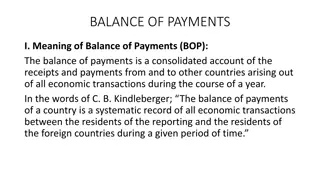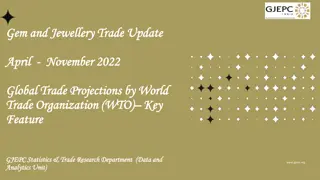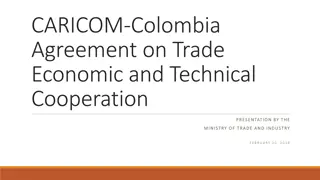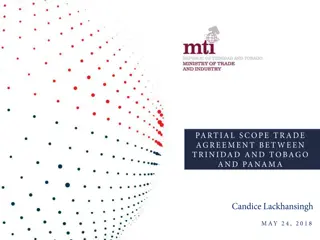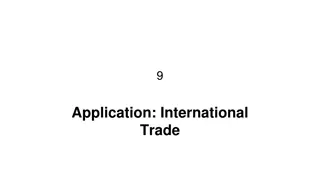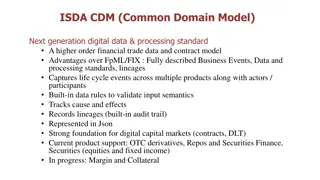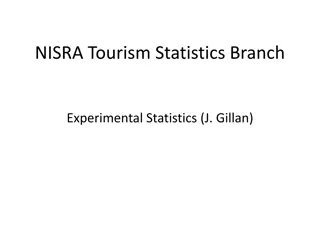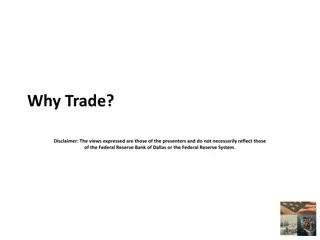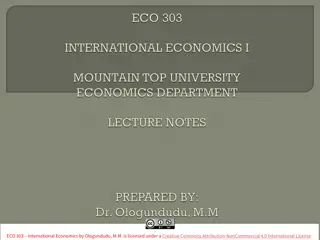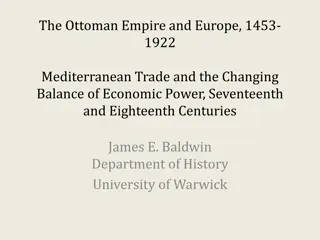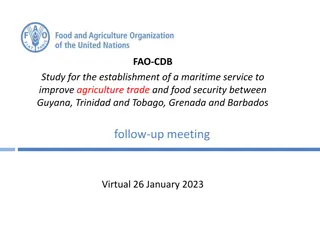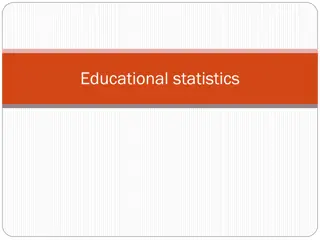Understanding Merchandise Trade Statistics - Insights and Applications
IMTS focuses on providing data on goods movement between countries. It follows the General Trade System, adheres to international standards, and uses classifications like HS 2022 and SITC Revision 4. Data is sourced from various entities like Customs Department and State Trading Corporation. Revision of figures occurs quarterly, with finalization after 9 months, and data is disseminated monthly, quarterly, and yearly.
Download Presentation

Please find below an Image/Link to download the presentation.
The content on the website is provided AS IS for your information and personal use only. It may not be sold, licensed, or shared on other websites without obtaining consent from the author. Download presentation by click this link. If you encounter any issues during the download, it is possible that the publisher has removed the file from their server.
E N D
Presentation Transcript
Merchandise Trade Statistics Ms B.Rooksana Moraby Deputy Director of Statistics
IMTS International (IMTS), refers to a specialised multipurpose domain of official statistics concerned with the provision of data on the movements of goods between countries. Merchandise Trade Statistics
Concepts External compiled in compliance with the United Nations Statistical recommendation Merchandise Trade Statistics are according to the General Trade System as recommended by the United Nations.
General Trade System Using the national boundary as the statistical frontier, the General Trade System is a record of all goods entering (imports) and leaving the country (exports).
International Standards While producing trade statistics, we adhere, where applicable, with the encouragements mentioned in the International Merchandise Trade Statistics (IMTS), IMTS 2010. recommendations and
Classifications Commodities are classified according to: Harmonised coding System (HS) 2022 For economic analysis and international comparison data are classified and published according Standard International Trade Classifications (SITC), Revision 4
Data Sources 1. Customs Department of the Mauritius Revenue Authority 2. State Trading Corporation 3. Mauritius Sugar Syndicate 4. Mauritius Port Authority 5. Air Mauritius
Revision of figures Provisional data are published quarterly with a time lag of 2 months and are finalised after 9 months Users are informed of all revisions made to data by the use of footnotes in the tables published. Methodology annexed to publications Documentation on revision to methodology is annexed to publications.
Data dissemination Trade statistics are released on a monthly, quarterly and yearly basis. Monthly: 7 weeks after reference month Quarterly: 2 months after reference quarter Yearly : 9 months after reference year
Publications Monthly Monthly bulletin on External Trade seven weeks after a reference month Quarterly A quarterly Economic and Social Indicator on External Trade which comprises of: (i) Imports/exports by country (ii)Trade with International or Regional Organisations such as ACP, SADC, COMESA etc. (iii)Imports/exports by commodity/section (iv) Forecasts based on inputs from Trade and Manufacturing Forecast Committee which include representatives from relevant Ministries, private sector and Bank of Mauritius
Publications (contd.) Annual An annual Digest of External Merchandise Trade Statistics Other publications on SM website Quarterly trade series including the trade balance are posted on SM website Export and Import Price Indices
Users of trade statistics Trade statistics are compiled to serve the needs of all users,. Different users need different data, ranging from data sets by country and commodity at varying levels of detail to aggregated figures. Most of our users have recourse to the monthly detailed trade data on our website Detailed trade data (Imports, domestic/reexports/total exports) by HS/SITC/country/month/mode of transport/quantity, value CIF/FOB Monthly data available as from 2005
Useful links To access: Trade statistics: https://statsmauritius.govmu.org/Pages/Statistics/By _Subject/External_Trade/SB_External_Trade.aspx Detailed trade data by HS, country and month: https://statsmauritius.govmu.org/Pages/Statistics/By_S ubject/External_Trade/Detailed_Trade_Data.aspx Note For most of the request received i.c.w. trade statistics, the data are already available under the link Detailed trade data by HS, country and month
Trade by continent Exports by Continent, 2018 - 2022 Imports by Continent, 2018 - 2022 40,000 35,000 180,000 30,000 160,000 140,000 25,000 Rs Million Rs Million 120,000 20,000 100,000 15,000 80,000 60,000 10,000 40,000 5,000 20,000 0 0 2018 2019 2020 2021 2022 2018 2019 2020 2021 2022 Europe Asia Africa America Oceania Europe Asia Africa America Oceania Imports from Africa was 14% of total imports in year 2022. Imports from Africa grew by 51.4%. Exports to Africa represented 29% of total exports in year 2022. Also, an increase of 24.1% in exports to African countries was noted in 2022.
Trade with Top 10 countries in Africa Exports to Top 10 African Countries, Year 2022 Imports from Top 10 African Countries, Year 2022 Value(c.i.f.): Rs Million Value(f.o.b.): Rs Million Imports Value Exports Value South Africa 26,475 South Africa 11,090 Seychelles 3,032 Madagascar 7,451 Kenya 2,244 Kenya 2,537 Egypt 2,174 Seychelles 1,216 Madagascar 1,796 Tanzania 557 Mozambique 638 Comoros 250 Zimbabwe 598 Mozambique 237 Morocco 542 Eswatini 168 Benin 372 Namibia 103 Tunisia 351 Zimbabwe 93 South Africa remained our main buyer and supplier in Africa
Trade by Commodities Exports to African Countries by main SITC sections, 2022 Imports from African Countries by main SITC sections, 2022 Miscellaneous manufactured articles 4% Manufactured goods classified chiefly by material 6% Beverages and tobacco 1% Machinery and transport equipment 11% Food and live animals 18% Food and live animals 26% Miscellaneous manufactured articles 40% Chemicals and related products, n.e.s. 8% Chemicals and related products 6% Beverages and tobacco 9% Crude materials, inedible, except fuels 10% Manufactured goods classified chiefly by material 26% Mineral fuels, lubricants and related materials 28% Machinery and transport equipment 7%









